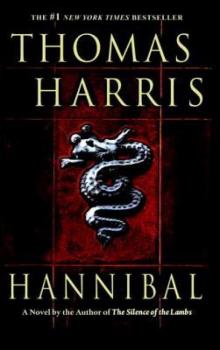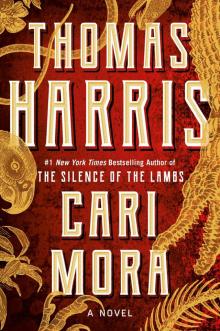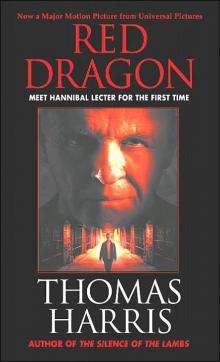- Home
- Thomas Harris
The Silence of the Lambs Page 7
The Silence of the Lambs Read online
Page 7
The lecturer pointed with his chin at the door behind her. Here it came. Her fate shied under her as she turned to see. But it was Brigham, the gunnery instructor, leaning into the room to point to her across the crowd. When she saw him, he beckoned.
For a second she thought they were throwing her out, but that wouldn’t be Brigham’s job.
“Saddle up, Starling. Where’s your field gear?” he said in the hall.
“My room—C Wing.”
She had to walk fast then to keep up with him.
He was carrying the big fingerprint kit from the property room—the good one, not the play-school kit—and a small canvas bag.
“You go with Jack Crawford today. Take stuff for overnight. You may be back, but take it.”
“Where?”
“Some duck hunters in West Virginia found a body in the Elk River around daylight. In a Buffalo Bill-type situation. Deputies are bringing it out. It’s real boonies, and Jack’s not inclined to wait on those guys for details.” Brigham stopped at the door to C Wing. “He needs somebody to help him that can print a floater, among other things. You were a grunt in the lab—you can do that, right?”
“Yeee, let me check the stuff.”
Brigham held the fingerprint kit open while Starling lifted out the trays. The fine hypodermics and the vials were there, but the camera wasn’t.
“I need the one-to-one Polaroid, the CU-5, Mr. Brigham, and film packs and batteries for it.”
“From property? You got it.”
He handed her the small canvas bag, and when she felt its weight, she realized why it was Brigham who had come for her.
“You don’t have a duty piece yet, right?”
“No.”
“You gotta have full kit. This is the rig you’ve been wearing on the range. The gun is my own. It’s the same K-frame Smith you’re trained with, but the action’s cleaned up. Dry-fire it in your room tonight when you get the chance. I’ll be in a car behind C Wing in ten minutes flat with the camera. Listen, there’s no head in the Blue Canoe. Go to the bathroom while you’ve got the chance is my advice. Chop-chop, Starling.”
She tried to ask him a question, but he was leaving her.
Has to be Buffalo Bill, if Crawford’s going himself. What the hell is the Blue Canoe? But you have to think about packing when you pack. Starling packed fast and well.
“Is it—”
“That’s okay,” Brigham interrupted as she got in the car. “The butt prints against your jacket a little if somebody’s looking for it, but it’s okay for now.” She was wearing the snub-nosed revolver under her blazer in a pancake holster snug against her ribs, with a speedloader straddling her belt on the other side.
Brigham drove at precisely the base speed limit toward the Quantico airstrip.
He cleared his throat. “One good thing about the range, Starling, is there’s no politics out there.”
“No?”
“You were right to secure that garage up at Baltimore there. You worried about the TV?”
“Should I be?”
“We’re talking just us, right?”
“Right.”
Brigham returned the greeting of a Marine directing traffic.
“Taking you along today, Jack’s showing confidence in you where nobody can miss it,” he said. “In case, say, somebody in the Office of Professional Responsibility has your jacket in front of him and his bowels in an uproar, understand what I’m telling you?”
“Ummm.”
“Crawford’s a stand-up guy. He made it clear where it matters that you had to secure the scene. He let you go in there bare—that is, bare of all your visible symbols of authority, and he said that too. And the response time of the Baltimore cops was pretty slow. Also, Crawford needs the help today, and he’d have to wait an hour for Jimmy Price to get somebody here from the lab. So you got it cut out for you, Starling. A floater’s no day at the beach, either. It’s not punishment for you, but if somebody outside needed to see it that way, they could. See, Crawford is a very subtle guy, but he’s not inclined to explain things, that’s why I’m telling you.… If you’re working with Crawford, you should know what the deal is with him—do you know?”
“I really don’t.”
“He’s got a lot on his mind besides Buffalo Bill. His wife Bella’s real sick. She’s … in a terminal situation. He’s keeping her at home. If it wasn’t for Buffalo Bill, he’d have taken compassionate leave.”
“I didn’t know that.”
“It’s not discussed. Don’t tell him you’re sorry or anything, it doesn’t help him … they had a good time.”
“I’m glad you told me.”
Brigham brightened as they reached the airstrip. “I’ve got a couple of important speeches I give at the end of the firearms course, Starling, try not to miss them.” He took a shortcut between some hangars.
“I will.”
“Listen, what I teach is something you probably won’t ever have to do. I hope you won’t. But you’ve got some aptitude, Starling. If you have to shoot, you can shoot. Do your exercises.”
“Right.”
“Don’t ever put it in your purse.”
“Right.”
“Pull it a few times in your room at night. Stay so you can find it.”
“I will.”
A venerable twin-engined Beechcraft stood on the taxiway at the Quantico airstrip with its beacons turning and the door open. One propeller was spinning, riffling the grass beside the tarmac.
“That wouldn’t be the Blue Canoe,” Starling said.
“Yep.”
“It’s little and it’s old.”
“It is old,” Brigham said cheerfully. “Drug Enforcement seized it in Florida a long time ago, when it flopped in the ’Glades. Mechanically sound now, though. I hope Gramm and Rudman don’t find out we’re using it—we’re supposed to ride the bus.” He pulled up beside the airplane and got Starling’s baggage out of the backseat. In some confusion of hands he managed to give her the stuff and shake her hand.
And then, without meaning to, Brigham said, “Bless you, Starling.” The words felt odd in his Marine mouth. He didn’t know where they came from and his face felt hot.
“Thanks … thank you, Mr. Brigham.”
Crawford was in the copilot’s seat, in shirtsleeves and sunglasses. He turned to Starling when he heard the pilot slam the door.
She couldn’t see his eyes behind the dark glasses, and she felt she didn’t know him. Crawford looked pale and tough, like a root a bulldozer pushes up.
“Take a pew and read,” is all he said.
A thick case file lay on the seat behind him. The cover said BUFFALO BILL. Starling hugged it tight as the Blue Canoe blatted and shuddered and began to roll.
CHAPTER 11
The edges of the runway blurred and fell away. To the east, a flash of morning sun off the Chesapeake Bay as the small plane turned out of traffic.
Clarice Starling could see the school down there, and the surrounding Marine base at Quantico. On the assault course, tiny figures of Marines scrambled and ran.
This was how it looked from above.
Once after a night-firing exercise, walking in the dark along the deserted Hogan’s Alley, walking to think, she had heard airplanes roar over and then, in the new silence, voices calling in the black sky above her—airborne troops in a night jump calling to each other as they came down through the darkness. And she wondered how it felt to wait for the jump light at the aircraft door, how it felt to plunge into the bellowing dark.
Maybe it felt like this.
She opened the file.
He had done it five times that they knew of, had Bill. At least five times, and probably more, over the past ten months he had abducted a woman, killed her and skinned her. (Starling’s eye raced down the autopsy protocols to the free histamine tests to confirm that he killed them before he did the rest.)
He dumped each body in running water when he was through with it. Each was found in a diffe
rent river, downstream from an interstate highway crossing, each in a different state. Everyone knew Buffalo Bill was a traveling man. That was all the law knew about him, absolutely all, except that he had at least one gun. It had six lands and grooves, left-hand twist—possibly a Colt revolver or a Colt clone. Skidmarks on recovered bullets indicated he preferred to fire .38 Specials in the longer chambers of a .357.
The rivers left no fingerprints, no trace evidence of hair or fiber.
He was almost certain to be a white male: white because serial murderers usually kill within their own ethnic group and all the victims were white; male because female serial murderers are almost unknown in our time.
Two big-city columnists had found a headline in e.e. cummings’ deadly little poem “Buffalo Bill”: … how do you like your blueeyed boy Mister Death
Someone, maybe Crawford, had pasted the quotation inside the cover of the file.
There was no clear correlation between where Bill abducted the young women and where he dumped them.
In the cases where the bodies were found soon enough for an accurate determination of time of death, police learned another thing the killer did: Bill kept them for a while, alive. These victims did not die until a week to ten days after they were abducted. That meant he had to have a place to keep them and a place to work in privacy. It meant he wasn’t a drifter. He was more of a trapdoor spider. With his own digs. Somewhere.
That horrified the public more than anything—his holding them for a week or more, knowing he would kill them.
Two were hanged, three shot. There was no evidence of rape or physical abuse prior to death, and the autopsy protocols recorded no evidence of “specifically genital” disfigurement, though pathologists noted it would be almost impossible to determine these things in the more deteriorated bodies.
All were found naked. In two cases, articles of the victims’ outer clothing were found beside the road near their homes, slit up the back like funeral suits.
Starling got through the photographs all right. Floaters are the worst kind of dead to deal with, physically. There is an absolute pathos about them, too, as there often is about homicide victims out of doors. The indignities the victim suffers, the exposure to the elements and to casual eyes, anger you if your job permits you anger.
Often, at indoor homicides, evidences of a victim’s unpleasant personal practices, and the victim’s own victims—beaten spouses, abused children—crowd around to whisper that the dead one had it coming, and many times he did.
But nobody had this coming. Here they had not even their skins as they lay on littered riverbanks amid the outboard-oil bottles and sandwich bags that are our common squalor. The cold-weather ones largely retained their faces. Starling reminded herself that their teeth were not bared in pain, that turtles and fish in the course of feeding had created that expression. Bill peeled the torsos and mostly left the limbs alone.
They wouldn’t have been so hard to look at, Starling thought, if this airplane cabin wasn’t so warm and if the damned plane didn’t have this crawly yaw as one prop caught the air better than the other, and if the God damned sun didn’t splinter so on the scratched windows and jab like a headache.
It’s possible to catch him. Starling squeezed on that thought to help herself sit in this ever-smaller airplane cabin with her lap full of awful information. She could help stop him cold. Then they could put this slightly sticky, smooth-covered file back in the drawer and turn the key on it.
She stared at the back of Crawford’s head. If she wanted to stop Buffalo Bill she was in the right crowd. Crawford had organized successful hunts for three serial murderers. But not without casualties. Will Graham, the keenest hound ever to run in Crawford’s pack, was a legend at the Academy; he was also a drunk in Florida now with a face that was hard to look at, they said.
Maybe Crawford felt her staring at the back of his head. He climbed out of the copilot’s seat. The pilot touched the trim wheel as Crawford came back to her and buckled in beside her. When he folded his sunglasses and put on his bifocals, she felt she knew him again.
When he looked from her face to the report and back again, something passed behind his face and was quickly gone. A more animated mug than Crawford’s would have shown regret.
“I’m hot, are you hot?” he said. “Bobby, it’s too damned hot in here,” he called to the pilot. Bobby adjusted something and cold air came in. A few snowflakes formed in the moist cabin air and settled in Starling’s hair.
Then it was Jack Crawford hunting, his eyes like a bright winter day.
He opened the file to a map of the Central and Eastern United States. Locations where bodies had been found were marked on the map—a scattering of dots as mute and crooked as Orion.
Crawford took a pen from his pocket and marked the newest location, their objective.
“Elk River, about six miles below U.S. 79,” he said. “We’re lucky on this one. The body was snagged on a trotline—a fishing line set out in the river. They don’t think she’s been in the water all that long. They’re bringing her to Potter, the county seat. I want to know who she is in a hurry so we can sweep for witnesses to the abduction. We’ll send the prints back on a land line as soon as we get ’em.” Crawford tilted his head to look at Starling through the bottoms of his glasses. “Jimmy Price says you can do a floater.”
“Actually, I never had an entire floater,” Starling said. “I fingerprinted the hands Mr. Price got in his mail every day. A good many of them were from floaters, though.”
Those who have never been under Jimmy Price’s supervision believe him to be a lovable curmudgeon. Like most curmudgeons, he is really a mean old man. Jimmy Price is a supervisor in Latent Prints at the Washington lab. Starling did time with him as a Forensic Fellow.
“That Jimmy,” Crawford said fondly. “What is it they call that job…”
“The position is called ‘lab wretch,’ or some people prefer ‘Igor’—that’s what’s printed on the rubber apron they give you.”
“That’s it.”
“They tell you to pretend you’re dissecting a frog.”
“I see—”
“Then they bring you a package from UPS. They’re all watching—some of them hurry back from coffee, hoping you’ll barf. I can print a floater very well. In fact—”
“Good, now look at this. His first victim that we know of was found in the Blackwater River in Missouri, outside of Lone Jack, last June. The Bimmel girl, she’d been reported missing in Belvedere, Ohio, on April 15, two months before. We couldn’t tell a lot about it—it took another three months just to get her identified. The next one he grabbed in Chicago the third week in April. She was found in the Wabash in downtown Lafayette, Indiana, just ten days after she was taken, so we could tell what had happened to her. Next we’ve got a white female, early twenties, dumped in the Rolling Fork near I-65, about thirty-eight miles south of Louisville, Kentucky. She’s never been identified. And the Varner woman, grabbed in Evansville, Indiana, and dropped in the Embarras just below Interstate 70 in eastern Illinois.
“Then he moved south and dumped one in the Conasauga below Damascus, Georgia, down from Interstate 75, that was this Kittridge girl from Pittsburgh—here’s her graduation picture. His luck’s ungodly—nobody’s ever seen him make a snatch. Except for the dumps being near an Interstate, we haven’t seen any pattern.”
“If you trace heaviest-traffic routes backward from the dump sites, do they converge at all?”
“No.”
“What if you … postulate … that he’s making a dropoff and a new abduction on the same trip?” Starling asked, carefully avoiding the forbidden word assume. “He’d drop off the body first, wouldn’t he, in case he got in trouble grabbing the next one? Then, if he was caught grabbing somebody, he might get off for assault, plead it down to zip if he didn’t have a body in his car. So how about drawing vectors backward from each abduction site through the previous dump site? You’ve tried it.”
&
nbsp; “That’s a good idea, but he had it too. If he is doing both things in one trip, he’s zigging around. We’ve run computer simulations, first with him westbound on the Interstates, then eastbound, then various combinations with the best dates we can put on the dumps and abductions. You put it in the computer and smoke comes out. He lives in the East, it tells us. He’s not in a moon cycle, it tells us. No convention dates in the cities correlate. Nothing but feathers. No, he’s seen us coming, Starling.”
“You think he’s too careful to be a suicide.”
Crawford nodded. “Definitely too careful. He’s found out how to have a meaningful relationship now, and he wants to do it a lot. I’m not getting my hopes up for a suicide.”
Crawford passed the pilot a cup of water from a thermos. He gave one to Starling and mixed himself an Alka-Seltzer.
Her stomach lifted as the airplane started down.
“Couple of things, Starling. I look for first-rate forensics from you, but I need more than that. You don’t say much, and that’s okay, neither do I. But don’t ever feel you’ve got to have a new fact to tell me before you can bring something up. There aren’t any silly questions. You’ll see things that I won’t, and I want to know what they are. Maybe you’ve got a knack for this. All of a sudden we’ve got this chance to see if you do.”
Listening to him, her stomach lifting and her expression properly rapt, Starling wondered how long Crawford had known he’d use her on this case, how hungry for a chance he had wanted her to be. He was a leader, with a leader’s frank-and-open bullshit, all right.
“You think about him enough, you see where he’s been, you get a feel for him,” Crawford went on. “You don’t even dislike him all the time, hard as that is to believe. Then, if you’re lucky, out of all the stuff you know, part of it plucks at you, tries to get your attention. Always tell me when something plucks, Starling.
“Listen to me, a crime is confusing enough without the investigation mixing it up. Don’t let a herd of policemen confuse you. Live right behind your eyes. Listen to yourself. Keep the crime separate from what’s going on around you now. Don’t try to impose any pattern or symmetry on this guy. Stay open and let him show you.

 The Silence of the Lambs
The Silence of the Lambs Red Dragon
Red Dragon Hannibal
Hannibal Black Sunday
Black Sunday Cari Mora
Cari Mora Hannibal Rising
Hannibal Rising Red Dragon hl-1
Red Dragon hl-1 The Silence of the Lambs (Hannibal Lecter)
The Silence of the Lambs (Hannibal Lecter)